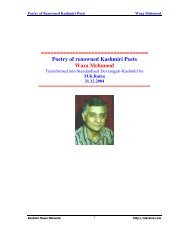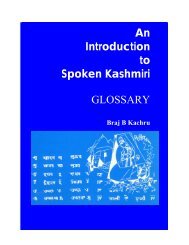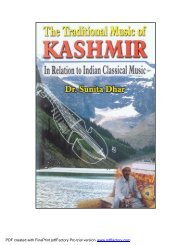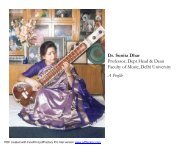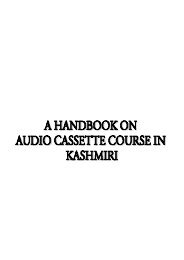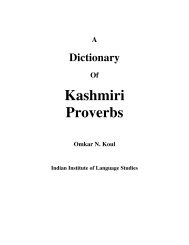Introductory Pages - An Introduction to Spoken Kashmiri
Introductory Pages - An Introduction to Spoken Kashmiri
Introductory Pages - An Introduction to Spoken Kashmiri
You also want an ePaper? Increase the reach of your titles
YUMPU automatically turns print PDFs into web optimized ePapers that Google loves.
<strong>An</strong> <strong>Introduction</strong> <strong>to</strong> <strong>Spoken</strong> <strong>Kashmiri</strong><br />
by Braj B. Kachru<br />
Muslims and the large scale conversion <strong>to</strong> Islam. This phase led <strong>to</strong> Persian (and Arabic)<br />
influences. The impact of the West on <strong>Kashmiri</strong> literature is recent.<br />
k?:s; ;; ;ur in Kashmir<br />
In the current language planning of Kashmir, k?:s;ur does not play an importatnt role. Kashmir is<br />
the only State of India in which a non-native language was introduced as the state language after<br />
the Independence. Thus, <strong>Kashmiri</strong>, which is the first language of 1,959,115 speakers, is not now<br />
in the language planning of the state. Though <strong>Kashmiri</strong> is the medium of instruction in the<br />
primary schools, the teachers have inadequate teaching materials and no motivation for teaching<br />
their own language. In this connection, the following observation continues <strong>to</strong> be true (see<br />
Kachru, 1969).<br />
The University of Jammu and Kashmir has so far shown no interest in research in <strong>Kashmiri</strong><br />
and/or other Dardic languages. One can count many reasons for this attitude (e.g., political,<br />
educational), but the main reason is the language-attitude of <strong>Kashmiri</strong>s <strong>to</strong>ward their own<br />
language. This attitude has developed over hundreds of years under varied foreign political and<br />
cultural domination and, in spite of the recent cultural upsurge, the attitude <strong>to</strong>ward the language<br />
has not changed. Perhaps this is why the Government and other educational institutions [14] do<br />
not seriously consider [k?:s;ur]under their academic domain.<br />
Notes and References<br />
1. Braj B. Kachru, “<strong>Kashmiri</strong> and Other Dardic Languages” in Current Trends in Linguistics,<br />
Vol. 5, ed. Thomas A. Sebeok (The Hague: Mou<strong>to</strong>n , 1969), p. 284.<br />
2. Registrar-General and Census Commissioner of India, Census of India, Vol. 1, Part 2,<br />
Language Tables (Delhi: 1965).<br />
3. In English a number of spellings have been used in literature for transliterating the word<br />
<strong>Kashmiri</strong>, e.g., Kaschemiri, Cashmiri, Cashmeeree, Kacmiri.<br />
4. For arguments in favor and against these two views, cf. G.A. Grierson, The Linguistic<br />
Survey of India, Vol. 8, Part 2, p. 235 and pp. 241-253; Sunitikumar Chatterji, Indo-Aryan<br />
and Hindi, 2 nd edition (Calcutta: 1960), pp. 130-131; Languages and Literatures of Modern<br />
India (Calcutta: 1963, pp. 33-34; M.S. Namus, “Origin of Shina Language” in Pakistani<br />
Linguistics 1962, Lahore, pp. 55-60; Census of India 1961, pp. ccii-cciii; Braj B. Kachru, op.<br />
cit.<br />
5. Sunitikamar Chatterji, Languages and Literatures of Modern India (Calcutta: 1963)., p. 256.<br />
6. G.A. Grierson, “The Linguistic Classification of <strong>Kashmiri</strong>”, Indian <strong>An</strong>tiquary, XLIV, (1915).<br />
7. For sub-classifications of languages/dialects under these three groups see: “The Dardic<br />
branch or sub-branch of Indo-European” in the supplement “Languages of the World: Indo-<br />
European Fascicle One” of <strong>An</strong>thropological Linguistics, Vol. 7, No. 8, Nov. 1965, pp. 284-<br />
294; Grierson, G.A., Linguistic Survey of India,Vol. 8, Part 2, p. 2; A. Mitra, Census of<br />
India, 1961, Vol. 1, an introduc<strong>to</strong>ry note on classification by R.C. Nigam, Registrar General,<br />
India, (Delhi: 1964), pp. ccii, cciii, ccxxxiv, 216, and 401. The following review article based<br />
on the available published literature, presents the same sub-classification as given in the<br />
above studies: Braj B. Kachru, “<strong>Kashmiri</strong> and Other Dardic Languages”, in Current Trends<br />
in Linguistics, Vol. 5, pp. 284-306. It seems that if Morgenstiern’s observation is correct,<br />
© 2006 Braj B. Kachru (http://kachru.com) 8<br />
http://koshur.org/<strong>Spoken</strong><strong>Kashmiri</strong>



